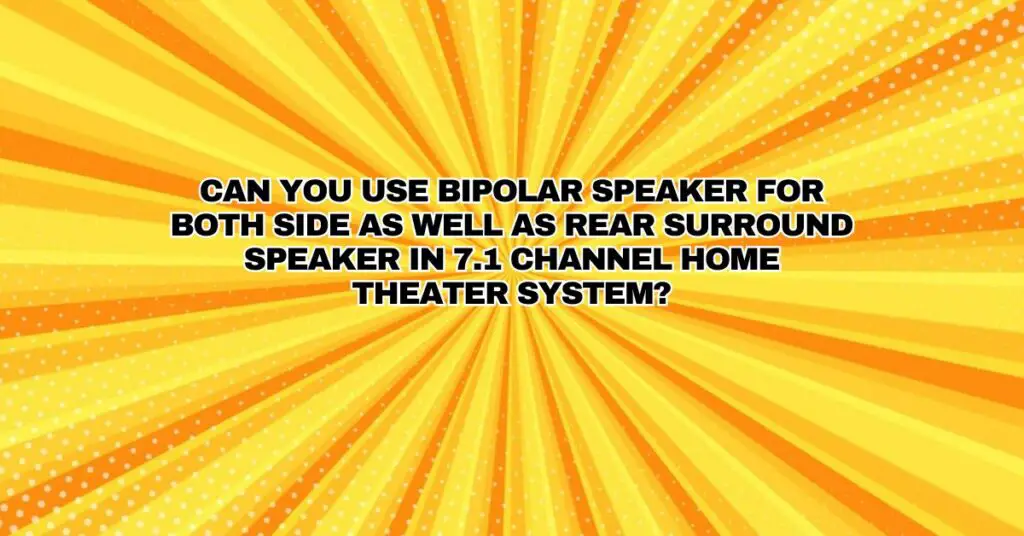Setting up a 7.1 channel home theater system allows for a truly immersive audio experience, but the choice of speakers and their placement is crucial to achieving the best results. When it comes to selecting surround speakers, bipolar speakers are a unique option. However, can you use bipolar speakers for both side and rear surrounds in a 7.1 channel system? In this comprehensive guide, we’ll explore the concept of using bipolar speakers in this manner, the benefits, and considerations involved.
1. Understanding Bipolar Speakers:
Bipolar speakers are designed to emit sound from both the front and rear of the speaker cabinet. They consist of two sets of drivers facing opposite directions, which create a dispersion pattern that fills the room with sound. Bipolar speakers are well-known for their ability to create a spacious and enveloping soundstage in home theater setups.
2. The 7.1 Channel Home Theater System:
A 7.1 channel system includes seven main speakers and one subwoofer. It’s configured as follows:
- Front Left and Right Speakers: These handle the main audio channels and are typically placed in front of the listener.
- Center Channel Speaker: This speaker is dedicated to dialogue and is usually positioned above or below the display screen.
- Subwoofer: Responsible for reproducing deep bass frequencies for added impact.
- Rear Surround Speakers (Surround Back): These speakers are positioned behind the listener to create a sense of space and immersion.
- Side Surround Speakers: Positioned on the sides of the listening area, these speakers are crucial for providing directional audio cues.
- Surround speakers: In a 7.1 setup, the rear surrounds (surround back) and side surrounds work together to immerse the listener.
Using Bipolar Speakers as Rear Surrounds in a 7.1 System:
Bipolar speakers can be effectively used as rear surround speakers in a 7.1 channel home theater system. Here’s how:
- Placement: Bipolar speakers are positioned behind the listener as the rear surrounds. They can provide a sense of envelopment and spaciousness, which is especially valuable for creating an immersive audio experience.
- Bipole vs. Dipole: Bipolar speakers emit sound from both the front and rear, creating a diffuse and enveloping soundfield. This differs from dipole speakers, which have drivers out of phase, resulting in a less direct and more ambient sound. Bipole speakers are often preferred for their more defined and impactful sound.
Advantages of Using Bipolar Speakers as Rear Surrounds:
- Spacious Soundstage: Bipolar speakers excel at creating a wide and spacious soundstage, contributing to a more immersive listening experience.
- Enveloping Sound: The dual dispersion pattern of bipolar speakers can provide an enveloping quality, making them well-suited for rear surrounds that are intended to immerse the listener in the audio.
- Consistency: Using bipolar speakers for both side and rear surrounds can result in a consistent timbre match across the entire surround sound system, ensuring a seamless audio experience.
Considerations When Using Bipolar Speakers:
- Room Size and Acoustics: Room size and acoustics play a significant role in the performance of bipolar speakers. In larger rooms, bipolar speakers can effectively fill the space, creating a more immersive experience. However, room treatment may be needed to optimize sound quality.
- Listener Preferences: Personal preferences are essential. Some listeners may prefer the enveloping quality of bipolar speakers, while others may lean towards more directional speakers, depending on their tastes.
In Conclusion:
Using bipolar speakers for both side and rear surrounds in a 7.1 channel home theater system is a viable and effective configuration. Bipolar speakers can create a spacious and enveloping soundstage, contributing to a more immersive listening experience. However, the choice ultimately depends on your room size, acoustics, and personal preferences. The most critical factor is achieving a well-balanced and cohesive audio experience that enhances your enjoyment of movies, music, and games in your home theater.


